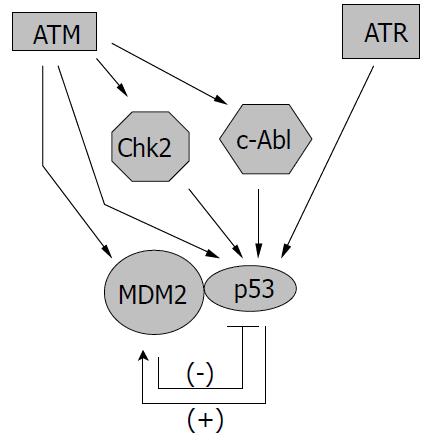Copyright
©The Author(s) 2004.
World J Gastroenterol. Jan 15, 2004; 10(2): 155-160
Published online Jan 15, 2004. doi: 10.3748/wjg.v10.i2.155
Published online Jan 15, 2004. doi: 10.3748/wjg.v10.i2.155
Figure 1 A general schematic representation of cellular re-sponses to genotoxic stress.
Ultraviolet (UV), ionizing radia-tion (IR), and various chemicals can induce DNA damage, such as double strand breaks (DSBs), which can be detected by “sensors”. This generates some signal that can be transduced by the transducers to effector molecules. Finally, there is the presence of an attenuation mechanism to control the cellular response to genotoxic stress.
Figure 2 Regulation of p53 protein by ATM and ATR.
ATM and ATR can influence the activity of p53 directly through phos-phorylation or indirectly through the action of other kinases. Furthermore, ATM can regulate p53 through phosphorylation of Mdm2 molecule, the negative regulator of p53, which can be up-regulated by p53.
Figure 3 The relationship between ATM and carcinogenesis.
- Citation: Yang J, Xu ZP, Huang Y, Hamrick HE, Duerksen-Hughes PJ, Yu YN. ATM and ATR: Sensing DNA damage. World J Gastroenterol 2004; 10(2): 155-160
- URL: https://www.wjgnet.com/1007-9327/full/v10/i2/155.htm
- DOI: https://dx.doi.org/10.3748/wjg.v10.i2.155











